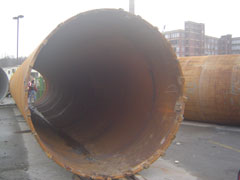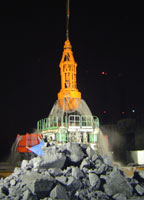 |
| Large-bore cutting bits are drilling shafts for almost 20,000 ft of stormwater tunnels. |
Complying with an environmental consent decree to stem polluting storm water and sewage from running into Narragansett Bay, Rhode Island officials have started a three-phase, $700-million-plus combined sewer overflow program in and around Providence. The initial work involves construction of a $165-million, 16,000-ft-long main spine storage and transport tunnel, seven 250-ft long drop shafts and 2,000-ft of interceptor lines.
 Click here to view map>>
Click here to view map>>
The 147-sq-mile Narragansett Bay is an estuary of national significance that has more than 400 miles of shoreline in Rhode Island and Massachusetts. Recreational fishing generates about $300 million annually, while bay related tourism contributes another $2 billion to the local economy. CSOs account for about 85% of point source fecal coliform contamination. In the past, high coliform counts after storm events have triggered several shellfish closures. The RI Dept. of Environmental Management and the Narragansett Bay Commission agreed on a cleanup plan in 1992. But federal rules changed in 1994 and after publicly reviewing 17 different remediation scenarios over a two-year period, NBC selected its current plan. The agency hired Gilbane/Jacobs Civil as agency construction managers and then broke ground on the first project in June 2001 for the Moshassuck River Interceptor. The main spine tunnel was awarded to ML Shank/Balfour Beatty in 2001, but the shafts were broken out to allow for local competition.
 |
| Japanese rotary casing driver takes a turn against Rhode Island capitol jobsite backdrop. |
Since then three shafts, including diversion, gate and screening structures have been completed and three more are scheduled for completion this year. One remaining shaft and structures, estimated at $4 million, will go out to bid this summer. The schedule calls for a 2007 completion. A pump station and the 26-ft finished diameter main line tunnel are scheduled for an early 2008 completion. "This is a storage and transport program," says Jamie R. Samons, NBC public affairs manager. "After the rain event, the flow, up to 65 million gal, is stored in the tunnel and pumped to the 42-million-gal-per-day Fields Point Wastewater Treatment Plant before discharge. We can control the flow rate to maximize treatment."
Fields Point came on line in 1901 but had fallen into disrepair. By the 1970s, the aged plant was pumping about 60 mgd of raw sewage into the bay. The NBC, which serves 360,000 people and 8,000 businesses, was formed in 1980 to correct the problem and oversaw a $100- million plant reconstruction in the 1980s. The 50-year-old, 22-mgd Bucklin Point plant is also undergoing a $70-million upgrade.
Taming CSOs was their second challenge. The NBC systems 66 CSOs were releasing about 2.2 billion gal of untreated sewage into the bay annually. Phase 1 is expected to reduce that by 40% and NBC estimates only four overflow events per year upon full completion.
Following a two-year construction hiatus to monitor water improvements and to study new technologies, phase 2 near-surface interceptors totaling over 30,000 ft running along the Seekonk and Woonasquatucket Rivers will be let in 2009/2010. The work is still in final design. Cost is estimated at around $125 million with a two-to-three-year completion schedule. Following another two-year break, phase 3 will begin. NBC plans to let bids for a three-mile-long, $300-million, 250-ft-deep storage and transport tunnel running along the Seekonk from Bucklin Point to Central Falls. All work is scheduled for a 2020/2021 completion. Owner specified microtunelling in congested area full of utilities.
Cambridge, Mass-based Modern Continental Construction Co. Inc.,which merged with Jay Cashman, Quincy, Mass in September 2004, is completing the $9-million Charles/Orms Street shafts. The contractor is drilling 2,000 ft of interceptor microtunnel about 30-ft below the surface to house a 48-inch spun fiberglass pipe. "The work involves five different drives between 300-ft to 500-ft each," says Vincent J. Calio, Modern project manager. "Were jacking the pipe behind the microtunnel boring machine. Three out of five drives are complete and work should wrap-up in July." He notes microtunneling was speced by the owner because the work is in a congested area in wet ground containing lots of utilities, which precludes open cut work. The two shafts are complete and the cast-in-place gate and screening work is under way but the precast diversion structure is not yet started.
 |
| Rhode Island hard rock no match for Supertop rotary casing driver. |
Moderns 7.5-ft and 8-ft shafts were drilled by Raito, Inc.,Crofton, Md. The contract's work horse is a Supertop rotary casing driver, which is relatively new in the states. "Supertop is a big rotator with huge torque up to 400 metric tons that turns up to 10-ft diameter casings and pushes down at the same time," says John R. Roma, Raito vice president. "The teeth can cut through boulders and obstructions making it very efficient in tough drilling conditions." A hammer grab removes spoils in the casing. The machine can drill down to about 200-ft and can be used in sensitive areas because it is vibration free. Supertop is made in Japan and was first used in Vermont in September 2003 on a 6.6-ft diameter, 190-ft deep shaft. This is the second American application but it is also being used on a nearby Providence bridge project.
(All photos courtesy of Raito Inc., Map courtesy of Naragansett Bay Commission)

Post a comment to this article
Report Abusive Comment